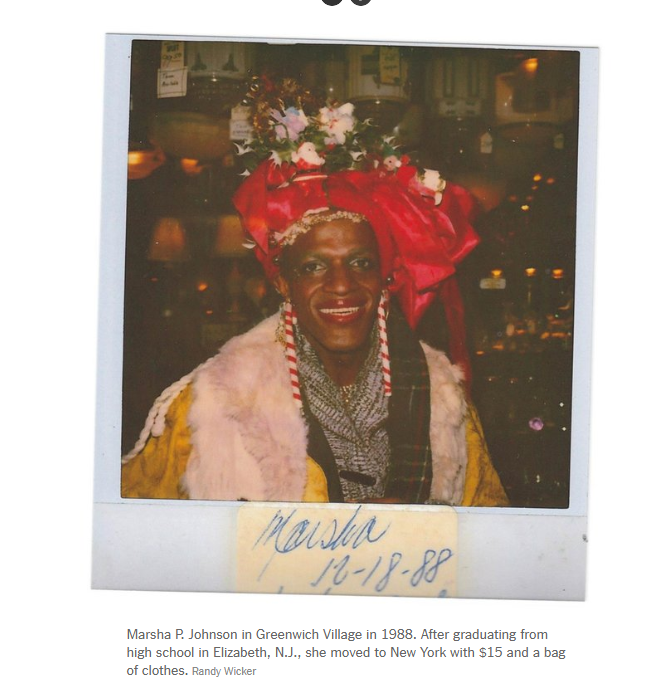““That’s what happened Stonewall night to a lot of people. We went, ‘Oh my God. I am not alone, there are other people that feel exactly the same way.’ “”
Marsha “Pay it no mind” Johnson was at The Stonewall Inn on the first night of the riots. Marsh, along with Silvia Rivera, are considered two of the main instigators of the Stonewall Uprising. Their forthright nature and enduring strength led them to speak out against the injustices they witnessed and endured.
Photo Credit: Randy Wicker
““As long as gay people don’t have their rights all across America,” she once said, “there’s no reason for celebration.””
“Hell hath no fury like a drag queen scorned!”
Silvia Rivera & Marsha P. Johnson
photo credit: unknown
“I’m a human being that survived. I helped other people survive.””
Tammy was an 18-year-old trans woman who, like Stormé and Marsha, was one of the first people to fight back.
She had lived with mob owner Fat Tony so was one of the few allowed to enter the bar in full women’s clothing. The bar was mostly made of a third white, third black and a third Hispanic with only a few trans women and drag queens allowed in, according to David Carter’s Stonewall biography.
Arrested and put in the paddy wagon for drag queens, Tammy escaped during the confusion.
According to researchers, it is unknown what happened to her after 1969.
Tammy Novak
photo credit: unknown
Stonewall riot veteran and gay rights activist Craig Rodwell, now deceased:
"There was a very volatile active political feeling, especially among young people,when the night of the Stonewall Riots came along, everything came together at that one moment. People often ask what was special about that night-there was no one thing special about it. It was just everything coming together, one of those moments in history that is: you were there, you know this is it, this is what we've been waiting for."
The Stonewall Uprising
LGBT patrons of the Stonewall Inn and members of the local community took the unusual action of fighting back during a routine police raid at the bar. The events during that six-day period are seen as a key turning point in the LGBT rights movement, with large numbers of groups forming around the country in the following years.
From June 28 to July 3, 1969, the Stonewall rebellion took place inside the Stonewall Inn at 51-53 Christopher Street, across the street in Christopher Park, and on several surrounding streets. The event is credited as a key turning point in the LGBT rights movement. As historian Lillian Faderman has written, Stonewall was “the shot heard round the world…crucial because it sounded the rally for the movement.”
The original Stonewall Inn was a gay bar that, like many other gay bars in the 1960s, was run by the Mafia. At 1:30 AM on Saturday, June 28, 1969, Stonewall was raided by the police. This was not an unusual occurrence. What was unusual was the reaction of the bar’s patrons and the crowd outside, which included a diverse segment of the local LGBT community as well as other residents of Greenwich Village and visitors.
Instead of dispersing, the angry crowd began to fight back as bar patrons were arrested, throwing beer cans and other objects at the police who were forced back into the bar. The demonstrating continued over the next few nights outside the Stonewall, in Christopher Park, and along adjacent streets between Seventh Avenue South and Greenwich Avenue.
The struggle for LGBT rights did not actually begin at Stonewall, as a number of groups in New York, Philadelphia, San Francisco, Los Angeles, and other cities had already been organizing and demonstrating for their equal rights. However, the Stonewall rebellion sparked the next major phase of the gay liberation movement, which involved more radical political action and assertiveness during the 1970s. Groups such as the Gay Liberation Front (GLF), the Gay Activists Alliance (GAA), Radicalesbians, and the Street Transvestite Action Revolutionaries (STAR) were organized within months of Stonewall.
At the one-year anniversary, the first annual Christopher Street Liberation Day March (later known as the Gay Pride March and then the LGBT Pride March) took place in New York, with similar events in other cities in the United States; the number of marches expanded internationally over the next few years.
In 1989, in honor of the 20th anniversary of the uprising, the section of Christopher Street in front of the Stonewall Inn was renamed Stonewall Place. The importance of Stonewall has further been recognized with the installation of George Segal’s sculpture Gay Liberation in Christopher Park in 1992. The buildings and/or the surrounding area have been listed on the National Register of Historic Places in 1999 and named a National Historic Landmark in 2000, a New York City Landmark in 2015, a New York State Historic Site in 2016, and a National Monument by President Barack Obama in 2016.
Today, LGBT people from around the world continue to visit Stonewall and recognize it as a major symbol of civil rights, solidarity, and remembrance. For example, on June 26, 2015, a large crowd gathered in celebration here after the United States Supreme Court declared state bans on same-sex marriage unconstitutional; a year later, people mourning the victims of the June 12, 2016 mass shooting at Pulse, a gay nightclub in Orlando, Florida, left flowers and messages on the sidewalk in front of Stonewall.








